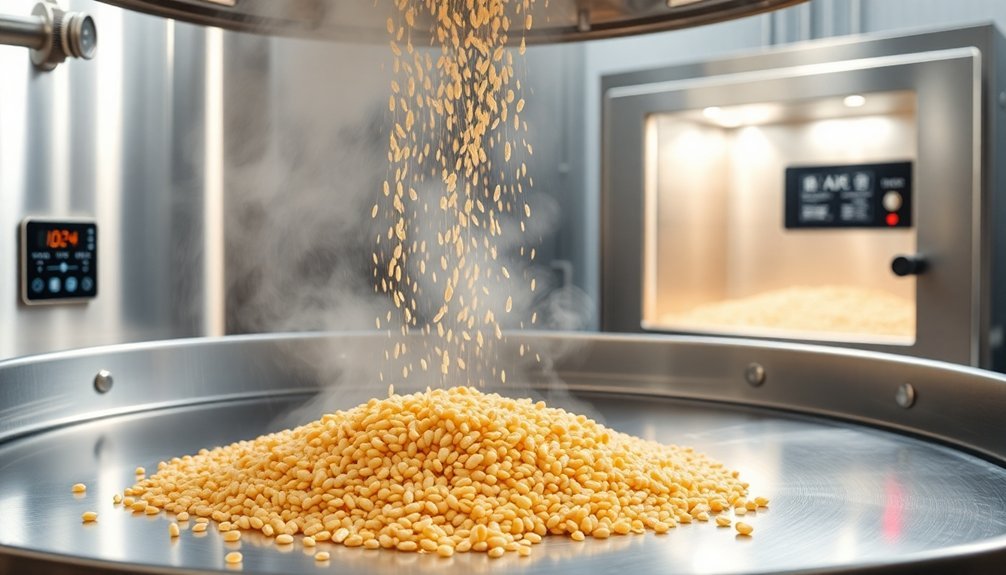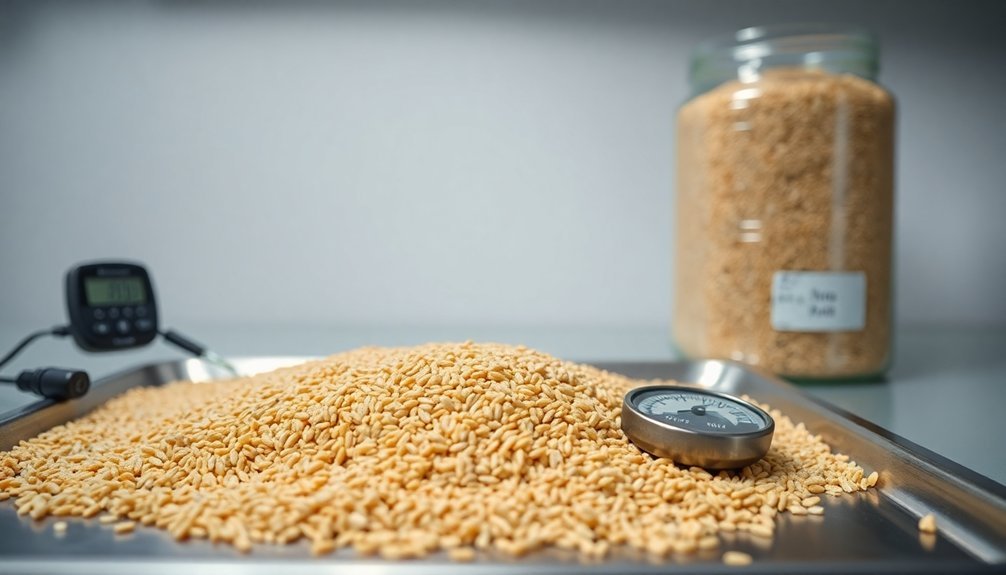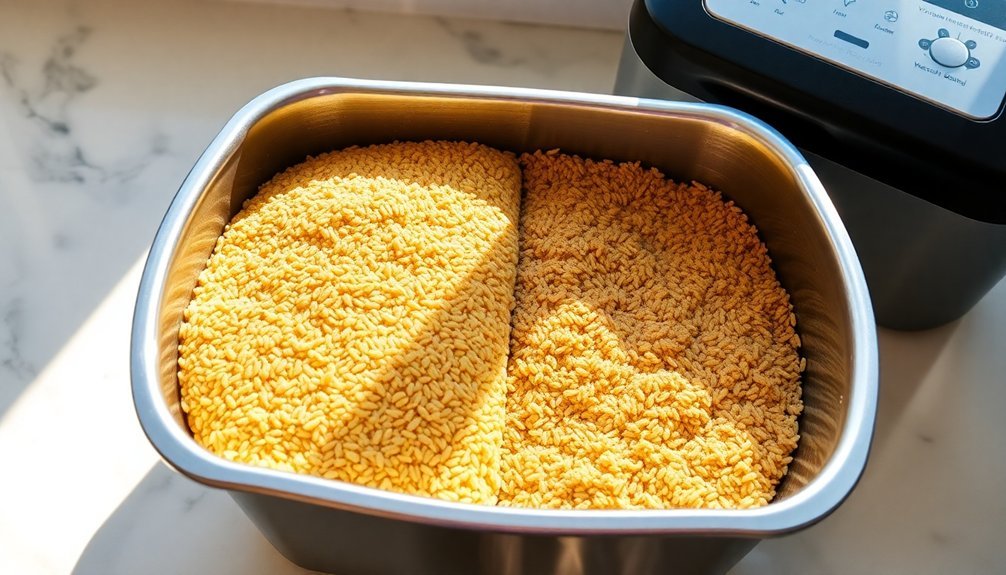To keep rice bran fresh, you'll need to control three key factors: temperature, moisture, and oxygen exposure. Store your rice bran at 50-70°F (10-21°C) in an airtight container, and maintain relative humidity around 70%. You'll want to guarantee the initial moisture content is between 8-9% through proper drying techniques. Quick stabilization after milling is essential – try heat treatment methods like microwave heating to deactivate enzymes that cause rancidity. Regular checks for off-putting odors, discoloration, or texture changes will help you catch spoilage early. These fundamental storage principles just scratch the surface of keeping your rice bran at peak freshness.
Proper Storage Temperature Guidelines

The ideal storage temperature for rice bran plays an essential role in maintaining its freshness and nutritional value. You'll want to store your rice bran between 50°F and 70°F (10°C to 21°C) to preserve its quality.
Temperatures around 18°C with 70% relative humidity offer particularly effective storage conditions for treated rice bran.
Regular inspections for rancid or sour odors are crucial when monitoring rice bran's freshness during storage.
If you're looking to extend your rice bran's shelf life, cooling and freezing are excellent options. Refrigeration at 4-5°C markedly slows down degradation and can add several months to its storage life.
For even longer preservation, you can freeze rice bran at 0°C or below, which can keep it fresh for up to a year.
You'll need to avoid areas with temperature fluctuations or excessive heat, as temperatures around 30°C can speed up degradation.
When using refrigeration, make sure to store your rice bran in airtight containers to prevent moisture absorption and odor transfer.
If you choose to freeze your rice bran, use freezer-safe bags or containers with minimal air space, and don't forget to label them with the storage date.
When you're ready to use frozen rice bran, thaw it in the refrigerator to minimize moisture condensation.
Preventing Moisture and Humidity Control
When managing rice bran storage, controlling moisture content and humidity levels stands as your primary defense against spoilage. You'll need to adjust the moisture content to 12-13% initially, then dry it to 8-9% for ideal stability. For specialized methods like microwave heating, you'll want to increase moisture to 20% before reducing it to 4-5% during stabilization. The process of twin-screw extrusion requires precise moisture control at 20% before drying to ensure proper stabilization results.
| Moisture Level | Impact | Control Method |
|---|---|---|
| Above 20% | High lipase activity, rapid spoilage | Immediate drying needed |
| 12-13% | Initial processing level | Forced draft drying |
| 8-9% | Standard storage level | Hot-air drying |
| 4-5% | Post-stabilization target | IR heating/tempering |
| Below 8% | Best for long-term storage | Depressurization drying |
To maintain freshness, you'll want to store your rice bran in laminated, metalized bags without vacuum sealing. Keep the storage environment at 18°C with 70% relative humidity rather than higher temperatures and humidity levels. Remember that moisture activates lipases, which lead to rancidity, so controlling humidity during storage is essential. You can use various drying methods like forced draft, hot-air, or IR heating to achieve your target moisture levels.
Essential Stabilization Methods

Managing moisture levels effectively leads directly to proper stabilization techniques for your rice bran. You'll need to implement specific methods to prevent enzymatic activity and maintain freshness. For maximum nutritional value, stabilize your bran quickly after milling since 90% of harvested bran typically ends up as animal feed due to rapid spoilage.
Heat treatment remains the most reliable approach, with dry heating being particularly effective at deactivating lipase enzymes that cause rancidity. You can also consider microwave heating at 130-880 W for quick stabilization, or infrared heating followed by tempering treatment to keep free fatty acids below 4%.
For those seeking alternatives to heat methods, you've got several viable options. Chemical stabilization and low-temperature storage can help inhibit enzyme activity, while fermentation using specific microorganisms can actually improve your rice bran's nutritional value.
- Combine heat treatment with moisture conditioning to maximize enzyme deactivation and guarantee proper heat transfer throughout the bran.
- Use extrusion puffing or expander systems when you need to both stabilize and compact the bran for storage.
- Consider ohmic heating when you want uniform heat distribution and efficient enzyme deactivation without damaging nutritional components.
These stabilization methods will help preserve your rice bran's quality and extend its shelf life considerably while maintaining its nutritional benefits.
Signs of Rice Bran Deterioration
You'll quickly notice when rice bran goes bad by its off-putting sour or musty smell, which is drastically different from its natural nutty scent.
Watch for visual warning signs like dark discoloration, fuzzy mold spots, or any foreign particles that weren't there before.
The texture will also tell you something's wrong if you find clumping, oily residue, or hard lumps instead of the usual dry, slightly coarse consistency.
Off-Putting Smell Changes
During the deterioration process, rice bran undergoes distinct smell changes that serve as clear warning signs of spoilage. When fresh, rice bran has a mild, nutty aroma, but as it deteriorates, you'll notice sour, musty, or rancid odors. These changes occur due to chemical reactions involving fats, which produce aldehydes and free fatty acids.
Temperature, humidity, and light exposure greatly impact how quickly these smell changes develop. You'll want to conduct regular sensory evaluations to catch early signs of spoilage, as off-putting smells indicate both nutrient degradation and potential safety issues.
To prevent unwanted odor changes, store your rice bran in airtight containers and keep it in a cool, dark place.
- Check for any shift from a pleasant nutty scent to sour or musty odors, as this is your first indicator of deterioration
- Trust your nose – if you detect strong, unpleasant smells, the rice bran has likely spoiled
- Consider refrigeration or freezing to extend freshness and prevent the development of off-putting odors
These smell changes are particularly rapid due to rice bran's high lipid content, making proper storage and regular monitoring essential for maintaining freshness.
Visual Warning Signs
Clear visual indicators help identify deteriorating rice bran before it becomes unsafe for consumption.
You'll want to monitor your rice bran's color closely, as fresh bran maintains a light brown shade. If you notice it darkening or showing inconsistent coloring, it's likely experiencing oxidation and becoming rancid.
Watch for any fuzzy spots that could indicate mold growth, which typically appears in green, white, or black colors. If you spot even the smallest amount of mold, you'll need to dispose of the rice bran immediately as it's no longer safe to use.
You should check regularly for foreign particles or contaminants that shouldn't be present in your rice bran. These unwanted elements can accelerate spoilage by promoting bacterial growth and enzyme activation.
Keep your storage areas clean to minimize contamination risks.
The texture of your rice bran can also reveal its condition. Fresh bran feels dry and slightly coarse to the touch. If you notice clumping or an oily residue developing, it's likely absorbing moisture or experiencing oil oxidation.
Store your rice bran in airtight containers to maintain its proper texture and prevent these issues.
Texture and Consistency Issues
Physical changes in rice bran texture serve as reliable warning signs of deterioration. When you're examining rice bran, you'll notice that fresh bran feels dry and slightly coarse to the touch. If it's spoiling, you'll detect clumping, oiliness, or an uneven consistency that signals enzymatic breakdown of fats.
Storage conditions play an essential role in maintaining proper texture. You'll need to keep your rice bran in a cool, dark place within an airtight container to prevent moisture absorption. Without proper storage, the bran's high fat content and lipase enzyme activity will cause rapid deterioration, leading to rancidity and unwanted texture changes.
- Check for sticky residue or hard lumps – these indicate moisture exposure and advanced spoilage
- Look for uniform texture throughout – clumping or separation suggests deterioration
- Monitor for oily patches – these reveal enzymatic breakdown of fats
You can extend your rice bran's shelf life by using clean utensils, avoiding double-dipping, and performing regular quality checks. If you notice any significant texture changes or signs of pest infestation, it's time to discard the bran.
Airtight Container Storage Solutions

To maintain rice bran's ideal freshness, selecting the right storage container becomes essential. You'll want to choose containers made of glass, metal, or high-quality plastic with tight-sealing lids. Clear acrylic or glass containers are particularly useful as they let you monitor the contents without opening them. Look for designs with secure locking clamps or reliable closure mechanisms to guarantee maximum protection.
When storing your rice bran, you'll need to focus on creating an airtight environment. Use containers with silicone gaskets in their lids or opt for vacuum-sealed bags to minimize air exposure. If you're using resealable plastic bags, squeeze out as much air as possible before sealing them. You can also double up on protection by keeping the original packaging inside your airtight container.
Don't forget to label your containers with storage dates and store them in a cool, dry place away from heat sources and direct sunlight. For best results, maintain a temperature of 4-5 degrees Celsius, which you can achieve through refrigeration.
Remember to regularly inspect your stored rice bran for any signs of spoilage, and discard it immediately if you notice any off odors or unusual changes.
Natural Antioxidant Preservation Techniques
You'll find several effective natural antioxidants for preserving your rice bran, including vitamin E which helps prevent rancidity and extends shelf life.
Natural plant extracts, particularly Moringa oleifera leaf powder, work as efficiently as synthetic preservatives in maintaining rice bran quality during storage.
Common spices with antioxidant properties can also protect your rice bran, while simultaneously enhancing its nutritional value and flavor profile.
Vitamin E Benefits
Vitamin E stands as one of nature's most powerful antioxidants, playing an essential role in preserving rice bran's freshness while offering significant health benefits.
When you consume rice bran products, you'll benefit from vitamin E's natural ability to protect cells from damage by scavenging harmful free radicals. This protection extends to the preservation of other essential nutrients, including vitamins A and C, which could otherwise deteriorate.
The presence of vitamin E in rice bran helps maintain its stability during processing and storage, ensuring you're getting maximum nutritional value. It's particularly effective at preventing the oxidation of fats and oils, which is vital for keeping rice bran fresh without artificial preservatives.
You'll find that this natural preservation method aligns with current consumer preferences for clean-label products.
- Supports your immune system function while protecting nerve and muscle health
- Works synergistically with other antioxidants to extend shelf life naturally
- Provides heart disease and cancer prevention benefits through dietary intake
Unlike synthetic preservatives, vitamin E's natural presence in rice bran means you won't have to worry about toxicity risks from regular consumption, as it's perfectly safe when obtained through food sources.
Natural Extract Solutions
Natural antioxidant preservation techniques have revolutionized the way we maintain rice bran's freshness, building upon vitamin E's protective properties.
You'll find that Moringa oleifera leaves serve as an exceptional natural preservative, offering potent antioxidant compounds that work as effectively as synthetic alternatives like BHT.
When you add Moringa oleifera leaf powder or extract to rice bran, you're reducing water activity and fat content while preserving protein levels.
These natural extracts work by reacting with lipid peroxyl radicals, effectively stopping lipid oxidation in its tracks. You're also getting additional protection through the extract's ability to inhibit microbial growth by lowering water activity.
You can maximize rice bran's shelf life by combining these natural solutions with proper storage conditions.
The process works in harmony with rice bran's inherent bioactive compounds, including tocopherols and γ-oryzanol, to maintain stability for up to 30 days.
You'll benefit from using these natural extracts as they avoid the potential drawbacks of synthetic preservatives while ensuring your rice bran stays fresh and nutritious throughout storage.
Spice-Based Preservation Methods
Within the domain of rice bran preservation, spice-based methods offer powerful antioxidant properties that rival synthetic preservatives. You'll find Moringa oleifera leading the charge, as its leaves contain bioactive compounds that naturally fight bacterial growth and reduce water activity in rice bran.
When you use either Moringa leaf powder (MOLP) or extract (MOLE), you're effectively preserving protein content while minimizing lipid degradation.
Natural compounds like alkylresorcinols (ARs) from grain bran work alongside spice-based solutions to protect your rice bran. While they're not as potent as Vitamin E or BHT, ARs effectively prevent mold and bacterial growth, especially in omega-3-rich oil emulsions.
You'll commonly find these compounds in wheat, rye, and barley.
- MOLP and MOLE can directly replace synthetic preservatives like BHT, offering a natural alternative that doesn't compromise effectiveness.
- Storage temperatures between 0°C and proper handling enhance the preservation effects of spice-based methods.
- Combining spice-based preservation with reduced water activity creates a synergistic effect that extends shelf life.
When you're implementing these methods, remember that proper storage conditions and handling practices greatly boost their effectiveness.
Processing Before Storage

Processing rice bran effectively requires immediate action after milling to prevent rancidity and maintain quality.
You'll need to clean the bran thoroughly to remove impurities and foreign materials, followed by proper moisture conditioning to achieve ideal moisture content levels.
You can stabilize your rice bran using either heating or non-heating methods. For heating stabilization, you've got several effective options: microwave heating at 6400 W and 2450 MHz for 15.75 minutes, infrared heating at 80-100°C with 4 hours of tempering, or traditional dry and steam heating processes.
These methods will keep your free fatty acid content under 4% during storage.
If you prefer non-heating approaches, you can use fermentation with fungi, yeast, or bacteria at 37-43°C for 12-24 hours. You might also consider using natural antioxidants or storing at 0°C to reduce lipase activity.
After stabilization, you'll need to dry the bran properly and store it in a controlled environment. When done correctly, your stabilized rice bran can last up to 6 months, especially during winter.
Don't forget to check FFA content regularly during storage to maintain quality.
Cold Storage Best Practices
Proper cold storage techniques greatly extend your rice bran's shelf life and maintain its quality.
You'll want to keep your rice bran at temperatures below 3°C to effectively inhibit lipase activity and prevent rancidity. The ideal storage temperature range is 4-5°C, which markedly slows down the increase in free fatty acids (FFA) and helps preserve nutritional properties.
Control your storage environment's humidity, aiming for around 70% relative humidity (RH). Higher humidity levels can accelerate spoilage, so you'll need to avoid environments above 78% RH.
For packaging, use laminated metalized bags without vacuum or zipper-top bags – surprisingly, vacuum packaging isn't recommended for extruded rice bran.
- Store rice bran at 4-5°C for up to 16 weeks to maintain low FFA content and prevent rancidity
- Keep relative humidity at 70% to minimize FFA formation and extend shelf life
- Use non-vacuum sealed packaging methods, such as laminated metalized bags or zipper-top bags
When you follow these cold storage practices consistently, you can preserve your rice bran for up to 6 months.
Remember that continuous cold storage is essential – even brief exposure to higher temperatures can trigger unwanted lipase activity.
Pest Control During Storage

Effective pest control stands as a critical component of rice bran storage management. You'll need to focus on proper container preparation and consistent monitoring to prevent insect infestations. Start by using tightly sealed containers made of glass, metal, or thick plastic, making certain they're thoroughly cleaned and treated with appropriate residual insecticides at least two weeks before use.
| Prevention Method | Implementation |
|---|---|
| Container Prep | Apply insecticide, repair cracks, make certain tight seals |
| Sanitation | Remove residual grain, vacuum regularly, destroy spills |
| Natural Deterrents | Add bay leaves, cloves, mint, or food-grade diatomaceous earth |
| Monitoring | Inspect weekly, check for webbing, discard infested product |
Don't forget to maintain cleanliness around your storage area by clipping tall grasses and removing spilled grain that could attract pests. You can enhance protection by incorporating natural repellents like bay leaves or mint, which won't affect the rice bran's taste. If you're in a region prone to infestations, consider using fumigants through proper dispensing devices. Remember to rotate your stock, using the oldest rice bran first to minimize storage duration and infestation risks. If problems persist, don't hesitate to consult professional pest control services.
Shelf Life Extension Methods
Rice bran's longevity depends heavily on proven stabilization techniques that prevent rancidity and nutrient degradation. You'll find that heat treatment methods are particularly effective, with infrared radiation heating at 100°C followed by tempering keeping free fatty acid levels under 4% for over four weeks.
When you're looking for peak shelf life, IR heating at 300°C reduces lipase and peroxidase activity considerably, extending storage time to 71.6 weeks at 4°C.
Microwave heating offers another reliable option, using 6400 W at 2450 MHz for about 16 minutes to stabilize the bran for up to 16 weeks. You can also consider alternative methods like ohmic heating or acid treatment to preserve nutritional value while controlling enzymatic activity.
- IR heating outperforms other methods for long-term storage, keeping rice bran fresh for over 70 weeks when stored at 4°C
- Continuous microwave heating effectively reduces free fatty acids while preserving nutritional quality
- Non-heating techniques like fermentation and acid treatment provide options for maintaining freshness without compromising nutrient bioavailability
Choose your stabilization method based on your storage duration needs and available equipment, keeping in mind that temperature control remains essential for ideal results.
Quality Assessment Before Storage

Before implementing any storage methods, thorough quality evaluation of rice bran helps predict its stability and storage potential. You'll need to check several key parameters, starting with the free-fatty acid content, which shouldn't exceed 2.72% for ideal storage conditions.
The moisture content directly impacts how well your rice bran will store, while checking for damaged grains and insect presence helps prevent future quality issues.
When evaluating physical characteristics, you'll want to examine the bran streaks on both regular and well-milled rice varieties. Pay close attention to the grain's whiteness, glossiness, and overall appearance.
Don't forget to evaluate the odor and taste of both raw and cooked samples, as these indicate initial quality levels.
The chemical composition requires special attention. You'll need to analyze the oil content, particularly the levels of oleic, linoleic, and palmitic acids.
Check the gamma-oryzanol content and lipase activity, as these affect storage stability. For microbiological safety, measure the total count of microorganisms, molds, and yeasts.
These baseline measurements will help you monitor changes during storage and adjust conditions accordingly.
Environmental Factors Affecting Storage
Several key environmental factors work together to keep your rice bran fresh during storage. Temperature plays an essential role, with the ideal storage range being 4-5°C to slow down the formation of free fatty acids.
You'll want to avoid temperatures above 25°C, as these accelerate chemical reactions and lipid oxidation that lead to spoilage.
Moisture control is equally important for preserving rice bran quality. Keep the moisture content below 5% and protect your storage from high humidity levels that exceed 75%.
You'll need proper packaging to achieve this – vacuum-sealed bags or airtight containers made of glass, metal, or thick plastic work best to keep moisture out while maintaining freshness.
- Store rice bran in cool, temperature-controlled environments with minimal fluctuations to prevent degradation
- Use moisture-proof packaging and guarantee proper sealing to protect against humidity and condensation
- Maintain good air circulation around stored rice bran to prevent warm air pockets and guarantee consistent temperature
Don't forget about ventilation – proper air circulation helps maintain uniform temperature throughout your storage space and prevents localized heating that can accelerate spoilage.
Frequently Asked Questions
Can Rice Bran Be Safely Fed to Pets as a Nutritional Supplement?
You can safely feed rice bran to your pets as a nutritional supplement. It's rich in vitamins, minerals, and fiber, but you'll need to introduce it gradually and use moderation. Always consult your vet first.
Does Organic Rice Bran Require Different Preservation Methods Than Conventional Varieties?
You'll find organic rice bran needs similar preservation methods as conventional types, but you can't use chemical stabilizers. Instead, you must rely on heat treatments, natural fermentation, and organic-approved enzymes for stabilization.
How Does Altitude Affect Rice Bran Storage Requirements?
While there's no specific data on altitude's direct impact, you'll want to maintain the same storage basics – keep your rice bran in airtight containers at 50-70°F with humidity below 60%, regardless of elevation.
Can Rice Bran Be Used as a Natural Fertilizer if Spoiled?
Yes, you can still use spoiled rice bran as fertilizer through composting. You'll need to mix it with nitrogen-rich materials and manage the carbon-to-nitrogen ratio to create an effective soil amendment for your plants.
Does Rice Bran From Different Rice Varieties Have Different Storage Requirements?
No, you don't need different storage methods for rice bran from various varieties. They all require the same conditions: cool temperatures, low humidity, and protection from light. Standard stabilization processes work equally well across varieties.
In Summary
You'll find that keeping rice bran fresh depends on multiple factors working together. Store it at cool temperatures (below 70°F), maintain low humidity levels, and use proper stabilization techniques. Always keep your rice bran in airtight containers, check regularly for signs of spoilage, and implement pest control measures. When you follow these guidelines carefully, you can extend your rice bran's shelf life considerably.





Leave a Reply